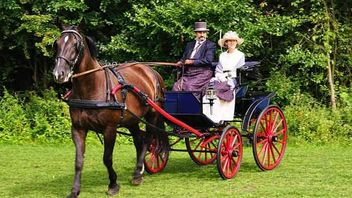
Dancing horses? Biomechanics of equestrian ballet…
Dancing horses? Biomechanics of equestrian ballet…
“People of music are usually smart, and time spent on explanations and advice is well spent.”
(ABM (Boni) Rietveld, “Injuries of dancers and performers”)
“Injuries can be caused by bad luck, fatigue and stress, but they are primarily due to faulty technique.”
Boni Rietveld is an orthopedic surgeon dedicated to the prevention, diagnosis and treatment of injuries in dancers and musicians.
The analogy between humans and horses must be approached with extreme caution, since the relationship between the physiology and neurophysiology of humans and horses is there are significant differences. However, as with dancers and musicians, the main cause of injury to horses is the faulty techniques and methods used in their work.
Dr. Rietveld drew his conclusion about the connection of incorrect techniques with injury as a result of 30 years of experience in the field. He also pointed out that the use of erroneous methods is often associated with ignorance of the permitted boundaries, of the physical limit of a person. During the same period of time, I observed how erroneous methods were used in the training of horses associated with banal illiteracy, ignorance of what requirements can be placed on horses (at one stage or another of their training and physical development), and which are not. Trainers, therefore, not only could not identify the cause of problems, but also correct them.
Most trainers/handlers know what a horse’s movements should look like, but don’t have a clear understanding of the basic laws of biomechanics.
In dance, ignoring physical limits creates a structural predisposition to injury. Similarly, in the field of riding and equestrianism, misanalysis or ignorance of the physical limits of horses are also sources of injury.
Rietveld wrote, “The dance teacher is the dancers’ first line of defense against injury.” To draw a parallel, we can say that a horse’s trainer is his first line of defense against injury.
Unfortunately, when knowledge is lacking, trainers and self-proclaimed masters become a major contributor to horse injuries. They advertise physical development, but only bring about a weakening of the body. Thus, when a horse is taught to perform lateral movements without prior training, by pulling on the “ropes” or actively assisting himself with a whip, the ignorance of the trainer will undoubtedly force the horse to perform what is required. However, her body will not be coordinated, balanced, which will create a prerequisite for possible subsequent injuries.
One of the main causes of horse injuries is work on movements and elements before the end of the growth process. First of all, people stop growing legs. The back “grows” the longest. Horses in this aspect develop in almost the same way.
In humans, the polyarticular muscles (rectus femoris, sartorius, and hamstrings) become temporarily “too short” and especially vulnerable to “growing pains.” With horses, everything happens the same way, only the list of muscles involved is different. The main thing here is the principle.
Dr. Rietveld remarked, “Because of this stiffness and discomfort, the student dancer is temporarily unable to lift the leg fully or swing high. In the best case, he is criticized by the teacher, who accuses him of laziness, begins to force him to work more, in the worst case, the student is injured.”
The same thing happens with horses. Horses are criticized by trainers, they are accused of laziness, forced to perform certain movements and … injuries appear.
Most primitive “training psychologies” describe the behavior of horses in terms of their social behavior and leadership, designating horse resistance as a purely behavioral problem. Based on the same categories, laziness is also evaluated. But these so-called behavioral problems are actually usually cries for help! Feeling discomfort or pain, the horse defends his body by resisting forward movement or lateral bending, another movement or element. When the trainer lacks knowledge, the horse has no hope of well-being.
Rietveld wrote, “Dancers are accustomed to discomfort, but because of their awareness of their body and because of the high physical demands, expected injury is noticed early, often before current imaging technologies show a deviation.” The same can happen to horses if the priority of the rider or trainer is not to force, but to train and coordinate the horse’s body. In horses, hesitation, delayed reactions, and slight kinematic anomalies can be signs that, if monitored and analyzed, can help prevent injury.
horse on video (video can be viewed on the author’s website), which served as the beginning of the reason for writing this article, recovered from navicular syndrome. Before she became severely lame, she had problems with tempo changes. She couldn’t do more than three or four changes in a row. The horse, after doing a short series of changes, needed to do a couple of triple strides at a canter before he could make another short series of changes to the pace. She, of course, was accused of laziness and forced to perform the element. As a result, she developed severe lameness in her right front leg and was diagnosed with an acute case of navicular syndrome.
An impaired kinematics of the limbs, causing excessive stress between the deep digital flexor and the navicular bone, is the result of spastic scoliosis in the cranial and thoracic region, bending the thoracic vertebrae on the right side. By correcting the imbalance of the back muscles, which caused the lateral position and reverse rotation of the thoracic vertebrae, it was possible to correct the anomaly of the kinematics of the limbs in order to remodel the recovery process. Navicular syndrome is primarily a remodeling disease. Abnormal stress shuts down the remodeling process, and since new cells are no longer created, degeneration occurs. The horse recovered and almost a year later, when he was asked to change at the pace, there was no problem even with a large series of changes. If instead of interpreting the horse’s difficulties as laziness, they would have been subjected to reasonable analysis, the horse would not have suffered from navicular syndrome – it simply would not have developed!
“Injuries to the knee, especially the patellofemoral joint, are the second most common injury (25% of all injuries) in dancers,” writes Dr. Rietveld).
Knee injuries are also common in horses. In dancers, such injuries often occur due to insufficient external rotation of the hips. “The knee rotates outward in flexion but not in extension. What dancers are not usually aware of is that they are using this phenomenon to compensate for the lack of movement in the hip: starting with the “demiplié”, the feet are in a position of overpronation and maximum outward rotation, locked on the floor, and the knees are extended. As a result, torque in the knees leads to rotational impairment in the patellofemoral joints and stretching of the medial structures. This is called “knee twisting”.
The left picture shows a “demiplié” performed with correct external rotation of the hip. In the photo on the right, we see the same movement performed by the same dancer, but with the wrong outward rotation. The dancer compensates for the lack of outward rotation of the hips with more flexion and rotation of the knees. The dancer twists his knees.
The rider twists the horse’s knees when he forces them to move by acting on them or manipulating them without maintaining the proper mechanics of the horse’s thoracic, lumbar, and pelvic spine. A horse’s hips cannot rotate outward like a human’s hips can. The similarity is that if the rider asks to make a movement by working on the horse’s legs with the whip without proper coordination of the thoracic and lumbar spine and pelvis, abnormal stresses can damage the knee joints as well as other joints. This is true when moving forward, this is true during lateral movements such as shoulder inward, half pass, etc. For example, during the swing phase, the hind limb and therefore the femur rotate around the hip joint. In synchronization with the pendulum movement of the femur around the hip joint, internal rotation of the femur occurs, from medial to lateral during swing and from lateral to medial during immobility. Normal kinematics of the limbs requires that the involvement of the hind legs combines pendulum movement of the limb around the hip joint and dorsal-ventral rotation of the pelvis. In his quantitative study comparing the kinematics of the limbs and the mechanism of the spines of horses with good movements, and the kinematics of the limbs and spines of horses with poor movements, Mikael Holmström noticed that horses with good movements showed good dorsal-ventral rotation of the pelvis.
If the trainer is unaware of the necessary correlation between pelvic rotation and forward swing of the limb, and encourages more engagement of the hind legs by touching the limbs with the whip, rotation will occur between the femur and tibia, injuring the knee joint. The trainer twists the horse’s knees…
Jean Luc Corny (source); translation by Valeria Smirnova.
- Helena (mushy ballerina) 14 September 2017 of
Comparison with human eversion is not entirely correct. And, by the way, eversion is not formed initially in dynamic movements, but primarily in static ones. And only then do the muscles that maintain the appropriate angle of abduction carefully develop. hips and muscles leading the leg in motion. Eversion contributes to a greater capture of space and freedom of movement. Not everyone has the opportunity to develop it. But tying a growing child’s neck is killing the whole organism. The pharmacy sells all sorts of orthopedic “braces” for the formation of posture. It’s funny, but for sick adults, they may help in some way. And a growing child will be killed by the spine. There are a lot of photos of young animals for sale on martingales, slippers, and so on … Looking at this, my heart bleeds. All the “coaches” in the choreography hall for at least six months … But the article is very good. Answer
- Maria 14 September 2017 of
Thank you very much for such an interesting comment! We plan to bring to the attention of site visitors a series of articles by this author and we will be glad if you take part in their discussion 🙂 Answer





